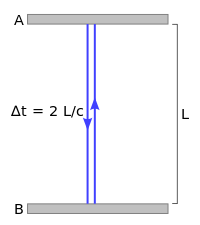Light Amplification by Stimulated Emission of Radiation(LASER) is a device that emits light. It is done by a process known as optical amplification where there is stimulated emission of photons.
The gain medium is a material with properties that allow it to amplify light by stimulated emission.A laser consists of a gain medium inside a highly reflective optical cavity, as well as a means to supply energy to the gain medium. In its simplest form, a cavity consists of two mirrors arranged such that light bounces back and forth, each time passing through the gain medium. Typically one of the two mirrors, the output coupler, is partially transparent. The output laser beam is emitted through this mirror.
Light of a specific wavelength that passes through the gain medium is amplified (increases in power); the surrounding mirrors ensure that most of the light makes many passes through the gain medium, being amplified repeatedly. Part of the light that is between the mirrors (that is, within the cavity) passes through the partially transparent mirror and escapes as a beam of light.
The process of supplying the energy required for the amplification is called pumping. The energy is typically supplied as an electrical current or as light at a different wavelength. Such light may be provided by a flash lamp or perhaps another laser. Most practical lasers contain additional elements that affect properties such as the wavelength of the emitted light and the shape of the beam.
History of LASER: MASER
In 1953, Charles Hard Townes and graduate students James P. Gordon and Herbert J. Zeiger produced the first microwave amplifier, a device operating on similar principles to the laser, but amplifying microwave adiation rather than infrared or visible radiation. Townes's maser was incapable of continuous output. Meanwhile, in the Soviet Union, Nikolay Basov and Aleksandr Prokhorov were independently working on the quantum oscillator and solved the problem of continuous-output systems by using more than two energy levels. These gain media could release stimulated emissions between an excited state and a lower excited state, not the ground state, facilitating the maintenance of a population inversion. In 1955, Prokhorov and Basov suggested optical pumping of a multi-level system as a method for obtaining the population inversion, later a main method of laser pumping.Townes reports that several eminent physicists — among them Niels Bohr, John von Neumann, Isidor Rabi, Polykarp Kusch, and Llewellyn Thomas — argued the maser violated Heisenberg's uncertainty principle and hence could not work. In 1964 Charles H. Townes, Nikolay Basov, and Aleksandr Prokhorov shared the Nobel Prize in Physics, “for fundamental work in the field of quantum electronics, which has led to the construction of oscillators and amplifiers based on the maser–laser principle”.
:






















